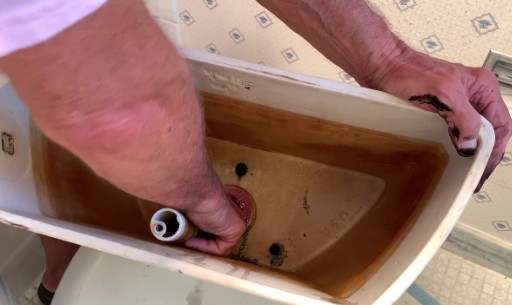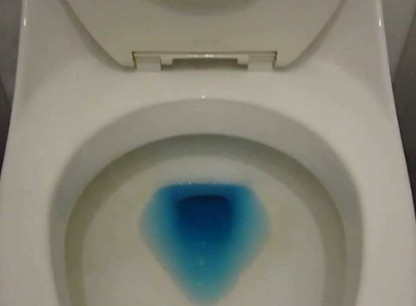Toilet problems come in different degrees, ranging from simple ones to more severe issues you cannot ignore, and flushing issues are a priority.
Therefore, it is in your best interests to address Kohler toilet flush problems because although these toilets are high quality, flushing issues creep in from time to time.
The flush problems you can face with your Kohler toilet include a weak flush, phantom flushing, slow filling tank, continuous running, and noisy flush. Before fixing these issues, you must troubleshoot to find out the causes.
Knowing how to address these problems is vital, especially if you are the handyman in your home. So, read on for causes and solutions to Kohler toilet flush problems.

Kohler Toilet Flush Problems (Causes and Fixes)
| Problems | Possible Causes | Recommended Fixes | |
| 1. | Weak Flush | Clogged trapway or rim jets Damaged flapper Faulty fill valve The low water level in the tank | Clear any obstructions Replace the flapper or fill valve Adjust the water level |
| 2. | Phantom Flushing | Worn-out flapper | Replace the flapper |
| 3. | Continuous Running | Malfunctioning flapper Damaged fill valve | Install a replacement flapper Clean or replace the valve, float, or valve diaphragm |
| 4. | Slow Filling Tank | Low water pressure Clogged fill valve Partially closed shut-off valve Blocked rim holes | Adjust the water pressure Remove debris and mineral deposits Fully open the shut-off valve Unclog the rim holes |
| 5. | Noisy Flush | Faulty flush valve Clogged rim holes | Replace the flush valve Unclog the rim holes |
1. Weak Flush
A good toilet clears your waste from the bowl with a single flush. This issue isn’t usually seen in new toilets, but you may encounter it after using your Kohler toilet for a while.
A lazy flush can happen for different reasons. These are:
a) Clogged Toilet Trapway or Rim Jets
The waste in the bowl clears if there’s an uninterrupted water flow from the tank to the bowl, all the way to the drainpipe. Therefore, the trapway and unblocked rim jets must be fully open.
Unfortunately, these parts can get clogged, preventing proper water flow and thus weakening the flush. Clogs usually happen due to mineral deposits or other obstructions like flushing paper towels.
b) Low Water Level In The Tank
Apart from flowing properly, water must also be sufficient to clean the bowl. Hence your toilet may not produce enough force to flush appropriately if the water level inside the tank is below the set mark.
c) Damaged Flapper
When your toilet flapper wears out, it stops providing a seal to prevent water from continuously flowing into the bowl when it isn’t in use. The outcome of this is diverse, including a weak flush.
d) Faulty Fill Valve
If your toilet’s fill valve isn’t working optimally, the tank won’t have enough water to deliver a strong flush.
Fix
- You can easily fix the clogged trapway and rim jets by unblocking the rim jet using a brush and vinegar. on the other hand, unclog the trapway with a plunger or auger.
- Adjust the float valve or fill valve or replace them.
- Install a new flapper. This quality 2-inch Kohler (BLUE PART GP85160 FLAPPER WITH FLOAT) (View on Amazon) is compatible with various Kohler toilet models and KALLISTA toilets.
2. Phantom Flushing
Surprisingly, phantom flushing is pretty common, but it is an issue you will want to address immediately because it is annoying and wasteful. This phenomenon refers to a situation where your toilet flushes unprovoked.
This problem can be caused by a bowl or tank leak, a faulty fill valve, or a float issue. However, a worn-out flapper is the most prevalent culprit.
In addition, in some cases, phantom flushing is caused by other factors such as high water pressure, a cracked tank or bowl, or a faulty pressure valve. It would be best to use professional help before the issues escalate.
Fix
Replacing the flapper valve is the most effective fix for phantom flushing. However, ensure this is the cause before acting.
In addition, conduct regular toilet maintenance to prevent this problem. The maintenance work includes regularly checking the flapper valve for wear and tear signs and cleaning the rim jets and trapway to prevent clogs.
Moreover, ensure the fill valve is functioning correctly or replace it.
3. Continuous Running
The first places to look are the fill valve and flapper if your Kohler toilet starts running nonstop. This is because the flapper controls water flow into the bowl while the fill valve refills the tank after a flush.
Therefore, a malfunctioning flapper will not have a full seal; hence the water will continue to flow into the bowl. Furthermore, when the fill valve malfunctions, it will let the water keep filling the tank resulting in water flowing into the tank.
The fill valve can get damaged for various reasons, such as sediment or debris buildup, a faulty valve diaphragm, or a damaged float.
Fix
- Install a replacement flapper.
- Fix a malfunctioning fill valve based on the cause of the problem. In that case, clean or replace the valve, float, or valve diaphragm.

4. Slow-Filling Tank
Typically, your toilet tank filling up slowly isn’t a big issue, especially if a single flush clears the bowl. However, you should not overlook or ignore this problem because it might be a sign of a bigger problem or simply escalate if left unsolved.
Below are the causes:
i) Low Water Pressure
Your toilet might fill up slowly if your home water pressure is low. The recommended water pressure for homes is 60 psi, with the ideal range being 40 to 80 psi, but it should never exceed 80 psi.
Test your water pressure with a pressure gauge. If you find that the water pressure is low, you may need to contact a plumber to check the plumbing system and determine the cause of the low pressure.
ii) Clogged Fill Valve
The flow of water into your toilet’s tank will be restricted if the fill valve is clogged with debris or sediment. Therefore, the tank will take longer to fill.
In addition, the tank will fill slowly or not fill up altogether if the fill valve is damaged.
iii) Partially Closed Shut-Off Valve
Water will not flow into your toilet tank efficiently if the shut-off valve is partially closed, which means reduced pressure. Moreover, the amount of water flowing through the fill valve will be reduced.
If the valve is partially closed, it can curb water flow and prevent the toilet from filling up efficiently.
iv) Blocked Rim Holes
The rim holes around the toilet bowl’s top help fill the bowl with water during each flush. However, these holes can get blocked by debris or mineral buildup, causing your toilet to fill up slowly.
Fix
- If you determine that your home has low water pressure, adjust the regulator screws of the pressure regulator with a wrench. This component is usually fitted where the supply line enters your home. However, if your home doesn’t have a pressure regulator, install a pressure-reducing valve.
- Clean the fill valve by turning off the water supply to the toilet, removing the valve cap, and cleaning the valve assembly. Alternatively, replace it.
- Fully open the shut-off valve to allow maximum water flow.
- Moreover, clean the rim holes using a wire hanger or a specialized toilet bowl cleaner.
5. Noisy Flushing
A noisy toilet is inconvenient as it can cause sleep disturbance and disrupt your otherwise peaceful home. Moreover, it can signify a bigger problem with your toilet if it is usually quiet.
Therefore, everyone prefers a quiet toilet because they are less disruptive and more comfortable. Flush valve problems or clogged rims can cause noisy flushing in a Kohler toilet; after all, hissing is among the Kohler Canister flush valve problems.
A damaged flush valve may not seal properly, which can cause water to leak through it during the flushing process. The leakage can result in a hissing or whistling noise during the flush.
Additionally, a flush valve that isn’t fully closing can allow water to continue flowing through the toilet bowl after the flush, resulting in a noisy and continuous water flow. This can occur when the flapper or seal of the flush valve is damaged, worn out, or misaligned.
On the other hand, clogged rim holes around the toilet bowl edge can cause a noisy flush by interfering with water flow during flushing. During a flush, water from the tank rushes into the bowl and exits through the rim holes, creating a siphoning action that pulls waste down the drain.
However, the rims must be fully open for proper water flow. Therefore, if they get clogged, the water won’t flow through them correctly, causing turbulence and air to be trapped within the water while flowing into the bowl.
This turbulence and trapped air can result in a gurgling or swirling noise during the flush. Insufficient water flow due to a clogged supply line or low water pressure can amplify the noise.
Fix
- Remove mineral buildup or debris blocking the rims with a wire or a descaling solution.
- Install a new flush valve. However, check the type of flush valve your toilet has. It could be the standard flush valve or a Kohler Canister flush valve.

How to Troubleshoot and Fix your Kohler toilet if it doesn’t flush
Follow these steps:
- Examine the tank’s water level, checking whether it’s too low. If it is, adjust your toilet’s fill valve. on the other hand, replace the fill valve if it exhibits signs of wear or damage.
- Lift the tank lid, then check the flapper. If it is damaged, worn out, or not sealing correctly, water won’t be able to flow from the tank into the bowl. So, adjust or replace it.
- Check if the chain is loose, too tight, or disconnected, then adjust it accordingly, reattach it, or replace it.
- Inspect the flush lever, then tighten it if loosely attached to the flapper chain or replace it.
- Clear clogs in your toilet bowl or drain line.
Concluding Thoughts on Kohler Toilet Flush Problems
You may enjoy a more extended grace period with a Kohler toilet because they are built to last. However, issues eventually arise, just like any other toilet. So, being prepared helps you approach different problems much better.
Here are other related posts:
